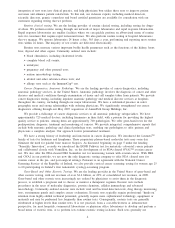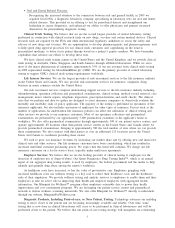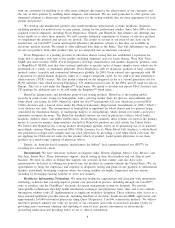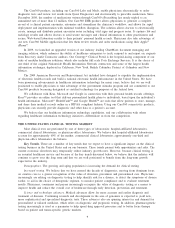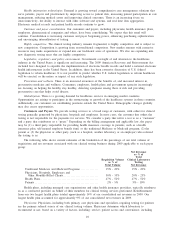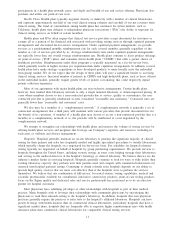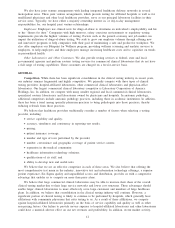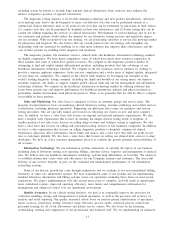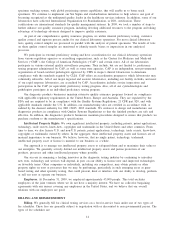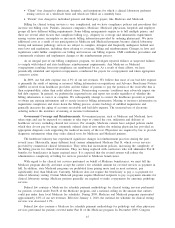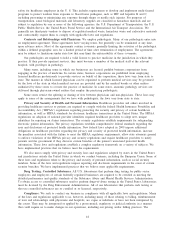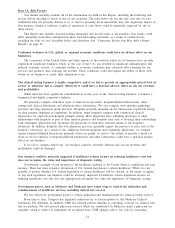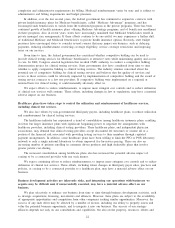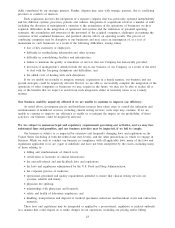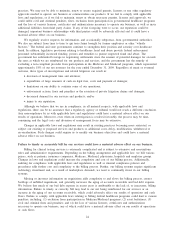Quest Diagnostics 2009 Annual Report Download - page 24
Download and view the complete annual report
Please find page 24 of the 2009 Quest Diagnostics annual report below. You can navigate through the pages in the report by either clicking on the pages listed below, or by using the keyword search tool below to find specific information within the annual report.specimen tracking system, with global positioning system capabilities, that will enable us to better track
specimens. We continue to implement our Six Sigma and standardization initiatives to help achieve our goal of
becoming recognized as the undisputed quality leader in the healthcare services industry. In addition, some of our
laboratories have achieved International Organization for Standardization, or ISO, certification. These
certifications are international standards for quality management systems. In 2009, we took a number of steps to
further enhance our quality assurance program, including devoting additional resources to the program and taking
advantage of technology advances designed to improve quality assurance.
As part of our comprehensive quality assurance program, we utilize internal proficiency testing, extensive
quality control and rigorous process audits for our clinical laboratory operations. For most clinical laboratory
tests, quality control samples are processed in parallel with the analysis of patient specimens. The results of tests
on these quality control samples are monitored to identify trends, biases or imprecision in our analytical
processes.
We participate in external proficiency testing and have accreditation for our clinical laboratory operations
from various regulatory agencies or accrediting organizations, such as the Centers for Medicare and Medicaid
Services (“CMS”), the College of American Pathologists (“CAP”) and certain states. All of our laboratories
participate in various external quality surveillance programs. They include, but are not limited to, proficiency
testing programs administered by CAP, as well as some state agencies. CAP is an independent, non-governmental
organization of board-certified pathologists approved by CMS to inspect clinical laboratories to determine
compliance with the standards required by CLIA. CAP offers an accreditation program to which laboratories may
voluntarily subscribe. All of our major regional and esoteric laboratories, including our facility in India, and most
of our rapid response laboratories, are accredited by CAP. Accreditation includes on-site inspections and
participation in the CAP (or equivalent) proficiency testing program. Also, all of our cytotechnologists and
pathologists participate in an individual proficiency testing program.
Our diagnostic products businesses maintain extensive quality assurance programs focused on compliance
with applicable regulatory requirements in the United States, Europe and Australia. They are regulated by the
FDA and are required to be in compliance with the Quality Systems Regulations, 21 CFR part 820, and with
applicable standards outside the U.S. In addition, our manufacturing sites are certified in accordance with, or
audited by the deemed authority for, ISO 13485: 2003 standards. We endeavor to design and manufacture our
diagnostics products in compliance with Quality Systems Regulations so that the finished products are safe and
effective. In addition, the diagnostics products businesses maintain procedures designed to ensure that products we
purchase conform to the manufacturer’s specifications.
Intellectual Property Rights. We own significant intellectual property, including patents, patent applications,
technology, trade secrets, know-how, copyrights and trademarks in the United States and other countries. From
time to time, we also license U.S. and non-U.S. patents, patent applications, technology, trade secrets, know-how,
copyrights or trademarks owned by others. In the aggregate, these intellectual property assets and licenses are of
material importance to our business. We believe, however, that no single patent, technology, trademark,
intellectual property asset or license is material to our business as a whole.
Our approach is to manage our intellectual property assets to safeguard them and to maximize their value to
our enterprise. We generally actively defend our intellectual property assets and pursue protection of our
products, processes and other intellectual property where possible.
Our success in remaining a leading innovator in the diagnostic testing industry by continuing to introduce
new tests, technology and services will depend, in part, on our ability to license new and improved technologies
on favorable terms. Other companies or individuals, including our competitors, may obtain patents or other
property rights on tests or processes that we may be performing, particularly in such emerging areas as gene-
based testing and other specialty testing, that could prevent, limit or interfere with our ability to develop, perform
or sell our tests or operate our business.
Employees. At December 31, 2009, we employed approximately 43,000 people. This total excludes
employees of the joint ventures where we do not have a majority interest. We have no collective bargaining
agreements with any unions covering any employees in the United States, and we believe that our overall
relations with our employees are good.
BILLING AND REIMBURSEMENT
Billing. We generally bill for clinical testing services on a fee-for-service basis under one of two types of
fee schedules. These fees are generally subject to negotiation with or discounted to non-governmental payers. The
types of fee schedules are:
14


